In this article, I am excited to share with you a variety of fruits that offer grape-like flavors and serve as delicious alternatives to grapes. Throughout history, fruits have undergone significant transformations through selective breeding, resulting in diverse fruit varieties and flavors that are reminiscent of grapes. From corn to watermelon, bananas to tomatoes, and many other fruits, we have a whole world of grape-like options to explore.
Whether you’re looking to try something new or simply curious about the evolution of fruits, discovering these alternatives can be a delightful experience. So, let’s dive in and explore some of these grape-like fruits and the fascinating stories behind their evolution!
Key Takeaways:
- There are many fruit varieties that offer grape-like flavors and serve as delicious alternatives to grapes.
- The evolution of fruits through selective breeding has resulted in diverse flavors and textures.
- Fruits like corn, watermelon, bananas, tomatoes, and eggplants have undergone significant transformations to become grape-like options.
- Dragon fruit and specialty grape varieties like Cotton Candy grapes provide unique and delightful flavors.
- Innovations in fruits like strawberries and pineapples have resulted in sweeter and more flavorful varieties.
Corn: From Teosinte to Maize
Corn, or maize, has a fascinating history. Its ancestors can be traced back to a Mexican grass called teosinte, which had skinny ears with a few dozen kernels. Through selective breeding, George W. Beadle, a Cornell University graduate student, discovered that maize and teosinte had similar chromosomes. He was able to get teosinte kernels to pop, indicating their close relation. Today, corn comes in various varieties and is a staple in many cuisines.
Over time, through the process of selective breeding, corn has evolved significantly from its wild ancestor, teosinte. This transformation has changed corn’s appearance, taste, and nutritional content. Today, we have a wide range of corn varieties, each with its own unique characteristics.
One remarkable development in the history of corn is the discovery made by George W. Beadle. While studying the genetics of maize, Beadle found that teosinte and maize shared similar chromosomes. This breakthrough revealed the close relationship between these two plants and demonstrated the potential to transform teosinte into the staple crop we know as corn.
Through selective breeding, maize has undergone a remarkable transformation, from a grass with a few dozen kernels to the diverse and widely consumed crop it is today.
Thanks to the efforts of researchers like Beadle and continued advancements in agricultural practices, corn has become an essential part of our diet. Different corn varieties are used for various purposes, including human consumption, livestock feed, and even industrial applications.
The Evolution of Corn
The evolution of corn can be summarized in the following stages:
- Wild Teosinte: Teosinte was the wild ancestor of maize. It had thin stalks, few kernels, and a different appearance compared to modern-day corn.
- Selective Breeding: Through centuries of selective breeding, humans started to work on improving teosinte by selecting plants with desirable traits such as larger, tastier kernels.
- Domesticated Corn: Over time, teosinte was transformed into domesticated maize, with larger ears, increased kernel size, and improved taste.
- Modern Varieties: Today, breeders continue to develop new corn varieties optimized for specific purposes, including sweet corn for fresh consumption and field corn for industrial uses.
The evolution of corn from teosinte to maize is a testament to the power of selective breeding and human ingenuity in transforming a humble grass into one of the world’s most important crops.
Watermelon: From Pale to Red Flesh
Did you know that watermelons have an ancient history dating back thousands of years? Archaeologists have discovered watermelon seeds at a 5,000-year-old settlement in Libya, and paintings of watermelons adorn Egyptian tombs over 4,000 years old. These ancient watermelons, however, looked quite different from the ones we find in our grocery stores today.
The early watermelons had pale flesh and were filled with numerous seeds, unlike the popular red-fleshed varieties we enjoy now. Through careful selective breeding, watermelons have undergone a transformation, resulting in the sweet and juicy red flesh we all love.
Over time, humans have selectively bred watermelons to enhance their flavor, texture, and appearance. This process involved selecting and cultivating watermelons with desirable traits such as sweeter flesh, fewer seeds, and improved coloration. As a result, today’s watermelons offer vibrant red flesh that is irresistibly juicy and refreshing.
Watermelons have become a beloved summertime fruit, perfect for picnics, barbecues, and pool parties. Their sweet flavor and high water content make them a delicious and hydrating treat on hot days. Whether enjoyed in slices, blended into smoothies, or served in fruit salads, watermelons are a refreshing addition that brings smiles to faces everywhere.
So, the next time you bite into a juicy, red watermelon, remember its ancient roots and the journey it has taken to become the luscious fruit we enjoy today.
The Evolution of Watermelons
- Ancient watermelons had pale flesh and abundant seeds.
- Selective breeding over centuries transformed watermelons into varieties with sweeter and juicier red flesh.
- Today’s watermelons are a refreshing summertime favorite, enjoyed for their vibrant color and delicious taste.
Bananas: From Wild to Seedless
In the world of fruit evolution, bananas have undergone a remarkable transformation. Today, we enjoy sweet and seedless bananas that are the result of careful selective breeding. But how did the humble wild banana evolve into the popular fruit we know today?
The story begins with two wild banana varieties: Musa acuminata and Musa balbisiana. Musa acuminata was a slender plant with small, okra-like pods. On the other hand, Musa balbisiana had large, hard seeds. These wild bananas were far from the sweet and seedless fruit we enjoy today.
Through selective breeding, farmers and researchers aimed to develop bananas that were sweeter, easier to eat, and had fewer seeds. By crossbreeding and selecting desirable traits, they transformed the wild bananas into the familiar yellow fruit found in supermarkets worldwide.
One important breakthrough in the evolution of bananas was the development of seedless varieties. By selecting and propagating plants that produced fruit without seeds, farmers created a more convenient and enjoyable eating experience. Seedless bananas eliminated the need for picking out pesky seeds while savoring this tropical delight.
Today, most commercially grown bananas belong to the Cavendish group, a cultivar derived from the wild banana varieties Musa acuminata and Musa balbisiana. The Cavendish bananas are prized for their sweetness, creamy texture, and seedless nature.
To understand the origins of bananas, researchers have turned to various disciplines, including archaeology, genetics, and linguistics. The evidence gathered from these fields sheds light on the fascinating journey of bananas from their wild ancestors to the cultivated, seedless fruit we enjoy today.
| Name | Description |
|---|---|
| Cavendish | The most widely available banana variety. Sweet, creamy, and seedless. |
| Gros Michel | Once popular but succumbed to Panama disease. Less sweet and smaller than Cavendish. |
| Lady Finger | A small, sweet variety with a slight tartness. Popular in Asia. |
| Plantain | Firm and starchy, often cooked and used in savory dishes. |
As we savor the sweet, seedless bananas in our fruit bowls, it’s worth appreciating the centuries of selective breeding and scientific exploration that have shaped this beloved fruit. From its wild ancestors to the modern Cavendish variety, bananas continue to delight taste buds around the world.
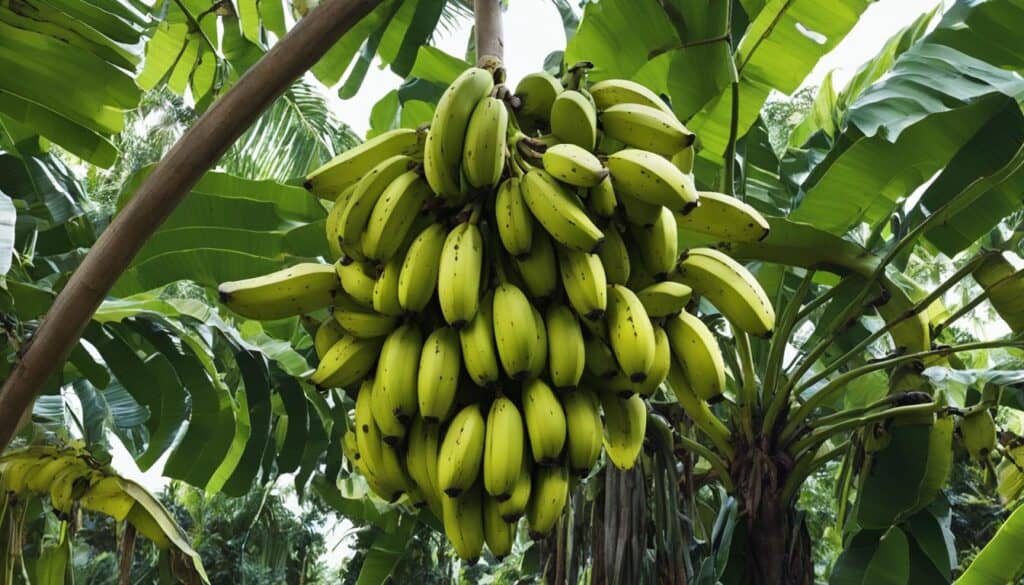
Carrots: From Off-White to Purple
Historical evidence suggests that ancient Greeks and Romans grew carrots, but they looked very different from the ones we know today. Early carrots were often off-white or purple in color and had a forked root. These carrots resembled their wild ancestors and were thinner in shape. Over time, selective breeding has led to the orange carrots that are most commonly seen today.
The Evolution of Carrots
“Carrots have a long and colorful history. Ancient carrots were diverse in shape and color, ranging from off-white and purple to yellow and red. However, it wasn’t until the 17th century that orange carrots became popular in Europe. The orange variety was developed in the Netherlands, where Dutch breeders selectively bred carrots to honor the royal House of Orange-Nassau. The vibrant orange color became synonymous with the carrot we know today.”
Let’s take a look at how the appearance of carrots has changed over time:
| Carrot Variety | Color | Root Shape |
|---|---|---|
| Ancient Wild Carrots | Purple, Off-white | Forked |
| 17th Century Dutch Carrots | Orange | Straight |
| Modern Carrots | Orange (Most Common), Red, Yellow, White, Purple | Straight |
As you can see from the table, carrots have undergone a significant transformation, both in color and shape. Through selective breeding, we now have a wide variety of carrot colors, including orange, red, yellow, white, and purple, allowing for more variety in culinary creations.
While orange carrots dominate the market, purple and rainbow carrots are gaining popularity for their vibrant hues and potential health benefits. Purple carrots contain anthocyanins, which are potent antioxidants that give certain fruits and vegetables their rich purple color. These antioxidants have been linked to various health benefits, including reducing the risk of chronic diseases.
So the next time you enjoy a crisp, sweet orange carrot, remember its fascinating journey from off-white and purple wild carrots to the modern varieties we have today.
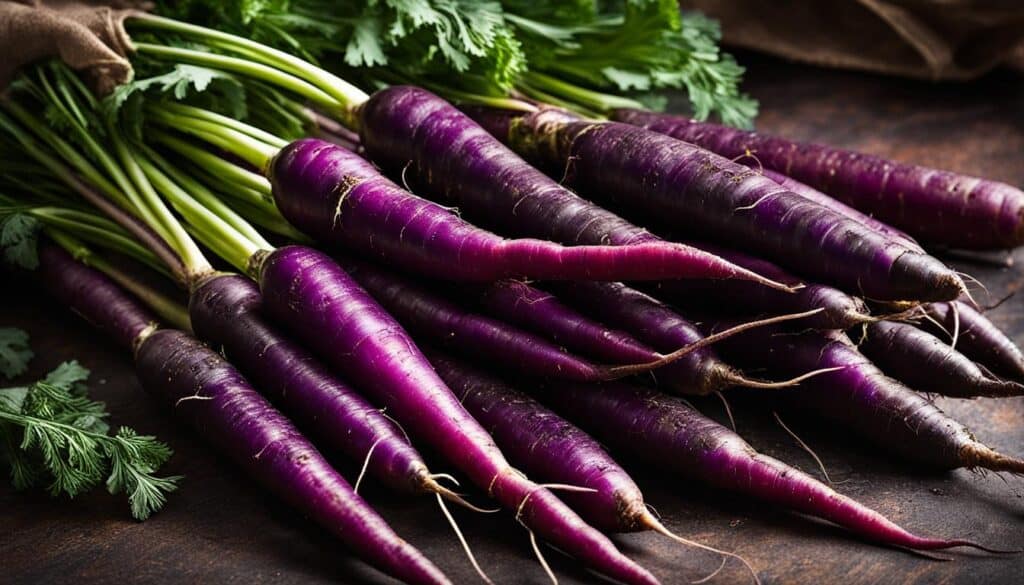
Apples: From Sour to Sweet
The modern apple has evolved from the Asian wild apple or Malus sieversii. This wild apple, native to the mountains of Central Asia, was small and sour in taste. Through selective breeding, apples have been transformed into a diverse fruit with a variety of flavors, including the sweet and crisp varieties commonly found in supermarkets.
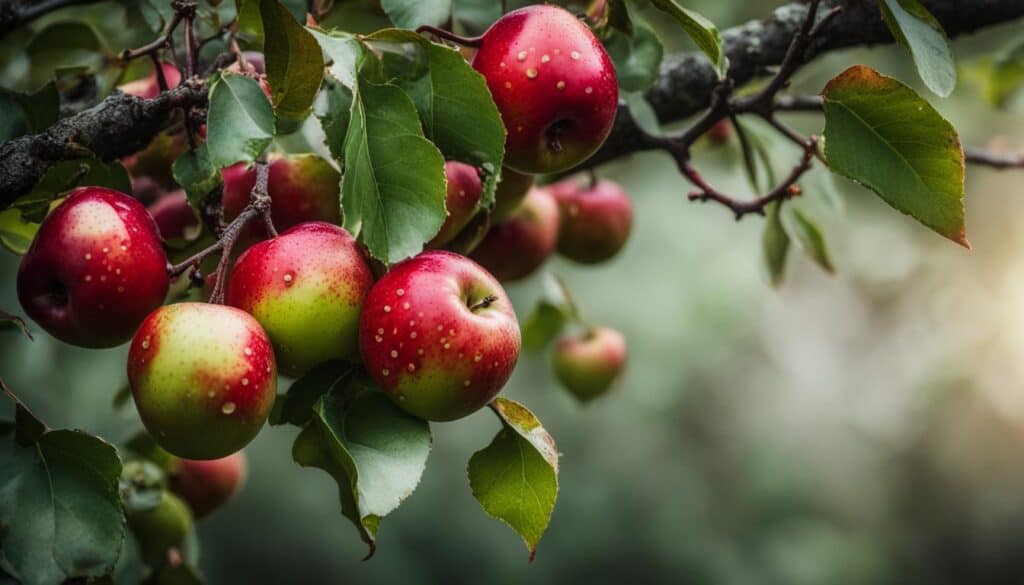
Selective breeding played a crucial role in the cultivation of apples, allowing for desirable traits to be enhanced and undesirable traits to be minimized. Over time, farmers and botanists carefully selected and crossbred apple varieties to create a wide range of flavors, sizes, and textures.
Today, we enjoy a vast selection of apple varieties, each with its own unique taste and texture. From the sweet and tangy Honeycrisp to the mildly sweet Gala, apples have become a beloved fruit around the world.
To showcase the popular apple varieties resulting from selective breeding, here’s a comparison table highlighting their different characteristics:
| Apple Variety | Flavor | Color | Size |
|---|---|---|---|
| Gala | Sweet with a hint of tartness | Red and yellow stripes | Medium |
| Honeycrisp | Explosively crisp and sweet | Mottled red and green | Large |
| Granny Smith | Tart and crisp | Bright green | Medium to large |
| Fuji | Sweet and juicy | Red and yellow | Medium to large |
As you can see, apples have come a long way thanks to the wonders of selective breeding. From their humble origins as small and sour wild apples, they have been transformed into a fruit that offers a wide variety of flavors to suit different preferences.
Tomatoes: From Small and Green to Versatile
In the fascinating world of fruit evolution, tomatoes have undergone a remarkable transformation through selective breeding. Early tomatoes were known for their tiny green or yellow fruit, quite different from the robust and colorful tomatoes we enjoy today. Let’s take a closer look at the journey of tomatoes from their humble beginnings to becoming a versatile and delicious fruit.
Tomatoes have a long history that traces back to the Aztecs, who used them primarily in cooking. These early tomatoes had small fruit and were not commonly consumed as stand-alone snacks. Instead, they were celebrated for their culinary potential, adding flavor and depth to a variety of dishes.
I chose tomatoes not just because I love the taste, but also because they are versatile ingredients that can be used in many different cuisines and dishes. They have a rich history and have been developed into numerous varieties through the process of selective breeding.
When explorers brought tomatoes back to Europe, they faced skepticism and fear. In the 1700s, tomatoes earned the nickname “poison apple” due to the erroneous belief that aristocrats had died after consuming them. This misconception arose because the acidity in tomatoes caused lead to leach from pewter plates, leading to lead poisoning.
However, through careful selection and breeding techniques, tomatoes have evolved into the versatile and delicious fruit we know today. They come in a wide array of colors, shapes, and sizes, ranging from juicy red beefsteak tomatoes to small and vibrant cherry tomatoes.
Tomatoes are now cherished for their incredible versatility in the kitchen. They can be enjoyed fresh in salads, used as a base for sauces and soups, grilled for added flavor, or even dried for a concentrated burst of sweetness. The possibilities are truly endless when it comes to incorporating tomatoes into your culinary creations.
To fully appreciate the range of tomato varieties available, let’s explore a table showcasing the diverse options:
| Tomato Variety | Description |
|---|---|
| Beefsteak | Large, juicy tomatoes perfect for slicing and adding to sandwiches |
| Roma | Oval-shaped tomatoes with low moisture content, ideal for making sauces and canning |
| Cherry | Small and sweet tomatoes, great for snacking or adding a burst of flavor to salads |
| Heirloom | Unique and visually striking tomatoes with diverse flavors, often passed down through generations |
As you can see, tomatoes have come a long way from their early days as small, green fruit. Through selective breeding, they have become a staple in many cuisines and offer a world of flavors to explore. Whether you’re a fan of classic beefsteak tomatoes or prefer the sweet tanginess of cherry tomatoes, there’s a tomato variety for everyone.
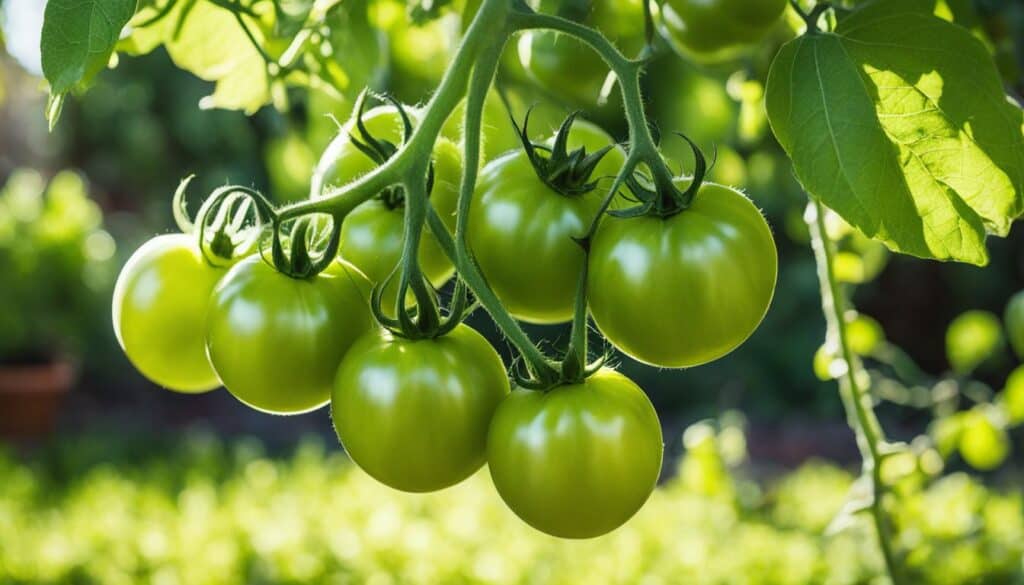
So, the next time you bite into a juicy tomato, take a moment to appreciate the incredible journey of this versatile fruit. From its humble beginnings to its wide-ranging varieties, tomatoes exemplify the power of selective breeding and the delicious possibilities it can create.
Eggplants: From White and Round to Purple
Eggplants, also known as aubergines, have a fascinating history of transformation through selective breeding. Historically, eggplants came in various colors, including white, yellow, azure, and purple. The name “eggplant” originated from the fact that the plants often produced white and round fruit. Some varieties even had spines, adding to their unique appearance.
However, through careful selective breeding, eggplants have been developed to have a consistent purple color and a variety of shapes and sizes. Purple eggplants are the most common type found in supermarkets and are widely used in various culinary dishes around the world.
Here is an image of a beautiful purple eggplant:
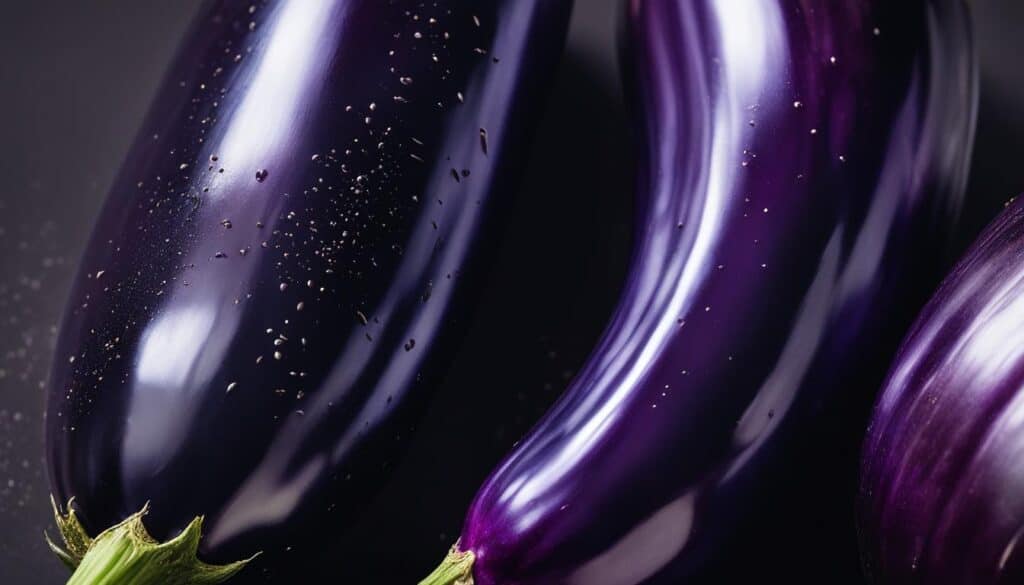
Early Eggplants: A Rainbow of Colors
Before the development of purple eggplants, early varieties showcased a diverse range of colors. Let’s take a look at some of these fascinating colors:
| Early Eggplant Colors |
|---|
| White |
| Yellow |
| Azure |
| Purple |
Eggplants have played a significant role in various cuisines around the world. From Mediterranean dishes like moussaka and baba ghanoush to Asian delicacies like eggplant stir-fry and curries, this versatile vegetable adds a unique flavor and texture to countless recipes.
By selectively breeding and refining the characteristics of eggplants, we have transformed them into the familiar and delicious purple fruits we enjoy today.
So the next time you’re at the grocery store, pick up a vibrant purple eggplant and explore the possibilities in your own kitchen!
Dragon Fruit: The Stunning Alternative
Dragon fruit, also known as pitaya, is a visually stunning fruit with bright pink or red skin and white flesh speckled with black seeds. It grows on cacti and has a sweet, mild, and almost floral flavor reminiscent of a mix between pear and kiwi.
This exotic fruit, with its vibrant appearance and refreshing taste, is gaining popularity in the United States. You can find dragon fruit available in various grocery stores and supermarkets, primarily from states like California, Florida, and Hawaii.
Indulging in the succulent flavor of dragon fruit is an excellent way to explore new taste sensations and add variety to your fruit choices. Whether enjoyed on its own, added to smoothies, or used as an ingredient in salads or desserts, dragon fruit provides a unique and delightful eating experience.
I was amazed by the striking appearance of dragon fruit the first time I saw it. Its vibrant colors instantly caught my attention, and when I tasted the sweet and refreshing flesh, I knew I had found something truly special.
– Jessica Miller, Fruit Enthusiast
Specialty Grapes: Cotton Candy and More
Grape breeding has revolutionized the world of grapes, bringing forth a delightful array of specialty varieties that offer unique flavors and experiences. One of the most popular specialty grapes is the Cotton Candy grape, which has gained fame for its uncanny resemblance to the beloved carnival treat. These grapes have been developed through meticulous grape breeding techniques to embody the sweet, fluffy essence of cotton candy, making them a favorite among grape enthusiasts.
But Cotton Candy grapes are just the beginning of this grape breeding revolution. Grape breeders have also created other specialty varieties, such as Gum Drop grapes and Gummyberries, each offering their own delightful taste profiles. Gum Drop grapes, as the name suggests, provide a burst of flavor reminiscent of your favorite grape candies, while Gummyberries offer a unique fruity flavor that will leave your taste buds pleasantly surprised.
Through the art of grape breeding, these specialty grapes have been carefully crafted to capture the essence of sweet flavors in every bite. The breeding process involves selecting grapes with desired traits, such as intense sweetness or unique flavor profiles, and then crossbreeding them to create new varieties with the desired characteristics. This intricate process requires skill, patience, and a deep understanding of grape genetics.
“The art of grape breeding allows us to explore the vast potential of flavors within the grape family. It’s like creating a symphony of tastes, where every grape variety brings its own unique note to the melody,” says Dr. Susan Davis, a renowned grape breeder.
The popularity of these specialty grapes has seen a significant surge in recent years, with high demand and sales skyrocketing. People are increasingly drawn to the novelty and excitement of trying grapes that offer flavors beyond the traditional grape taste. Whether you’re hosting a vibrant fruit platter, preparing a refreshing salad, or simply indulging in a sweet snack, these specialty grapes are sure to elevate any culinary experience.
So, if you’re ready to embark on a grape adventure like no other, be sure to explore the world of specialty grapes. With their unique flavors and sweet profiles, these grapes are redefining the boundaries of grape enjoyment and offering a tantalizing alternative to traditional grape varieties.
Discover the Sweet World of Specialty Grapes:
- Cotton Candy grapes: Transport yourself to the whimsical world of cotton candy with these irresistibly sweet grapes.
- Gum Drop grapes: Experience the nostalgia of your favorite grape candies with these flavor-packed grapes.
- Gummyberries: Indulge in the fruity goodness of these grape gems, offering unexpected and delightful flavors.
| Specialty Grapes | Flavor Profile |
|---|---|
| Cotton Candy grapes | Sweet and reminiscent of fluffy cotton candy |
| Gum Drop grapes | Intense grape candy flavor |
| Gummyberries | Delightful fruity flavors that surprise and entice |
Sweet Innovations: Designer Fruits
In addition to grapes, there are other fruits that have experienced exciting innovations to create updated varieties with sweeter and more flavorful profiles. These designer fruits are the result of careful breeding and have become a delightful alternative for those seeking unique taste experiences. Let’s explore two examples of these flavorful innovations: strawberries and pineapples.
Strawberries: Wow Berries and Tropical Bliss
When it comes to designer strawberries, Sunset Grown stands out with their exceptional varieties. Their Wow Berries and Tropical Bliss are sure to take your taste buds on a delicious adventure.
| Strawberry Variety | Description |
|---|---|
| Wow Berries | These strawberries are known for their vibrant color, succulent texture, and intense sweetness. Each bite is a burst of fruity flavor that will leave you craving for more. |
| Tropical Bliss | True to its name, Tropical Bliss brings the taste of the tropics to your plate. These strawberries have a hint of exotic flavors like pineapple and mango, creating a unique and delightful sensation. |
With their updated varieties, Sunset Grown has elevated the strawberry experience, offering a range of flavors that will make your dessert or snack time even more enjoyable.
Pineapples: Honeyglow Delights
Del Monte brings its expertise in fruit cultivation to create a remarkable designer pineapple called Honeyglow. This variety is a true delight for pineapple lovers.
The Honeyglow pineapple is characterized by its luscious golden flesh, superior juiciness, and exceptional sweetness. With every juicy bite, you’ll experience the full-bodied flavors of this updated pineapple variety.
Del Monte’s Honeyglow pineapple exemplifies the fruit’s natural sweetness and showcases the innovative efforts to bring a satisfying tropical experience to your palate.
By pushing the boundaries of fruit breeding, these designer fruits like Wow Berries, Tropical Bliss strawberries, and Honeyglow pineapples offer an exciting range of sweet flavors that go beyond traditional fruit varieties. Whether you enjoy them on their own, in salads, or as a garnish for your favorite desserts, these updated strawberry and pineapple options are sure to bring a burst of deliciousness to your table.
Conclusion
Throughout history, fruits have undergone a remarkable evolution, thanks to selective breeding. This process has led to a vast array of flavors and options, providing flavorful alternatives to grapes. From corn to watermelon, bananas to tomatoes, and many other fruits, we now have a diverse range of textures and tastes to enjoy.
These fruit varieties, cultivated through selective breeding, offer an exciting alternative to traditional grapes. Whether you’re searching for a new taste sensation or simply fascinated by the evolution of fruits, exploring these flavorful alternatives can be a truly delightful experience.
By understanding the techniques and effects of selective breeding, we gain a deeper appreciation for the rich history and immense ingenuity behind our favorite fruits. Through such processes, we have unlocked a world of flavors, textures, and colors that continue to captivate our palates.
So, the next time you’re looking to indulge in a grape-like experience, consider trying one of these flavorful alternatives. From the sweet and succulent flesh of watermelon to the vibrant and versatile tomato, there’s a dazzling array of options awaiting your exploration. Fruit evolution and selective breeding have truly given us an extraordinary bounty of delicious alternatives to grapes.
FAQ
What are some fruits that are similar to grapes and offer grape-like flavors?
Some fruits that are similar to grapes and offer grape-like flavors include watermelon, dragon fruit, and specialty grape varieties like Cotton Candy grapes.
How has corn evolved over time to become the maize we know today?
Corn, also known as maize, has evolved through selective breeding from its ancestor, teosinte, a Mexican grass with skinny ears. George W. Beadle, a Cornell University graduate student, discovered that maize and teosinte had similar chromosomes, leading to the development of different maize varieties.
What is the history behind watermelon and its red-fleshed variety?
Watermelons have a long history, with evidence of their existence dating back thousands of years. Early watermelons had paler flesh and more seeds. Through selective breeding, sweeter and juicier red-fleshed watermelons were developed.
How did bananas transform from their wild varieties to the seedless fruit we enjoy today?
Bananas have evolved from two wild varieties, Musa acuminata and Musa balbisiana. Selective breeding resulted in seedless bananas with a sweet taste and desired characteristics.
What did carrots look like in the past compared to the ones we know today?
Historically, carrots were off-white or purple and had a forked root. These carrots resembled their wild ancestors and were thinner in shape. Over time, selective breeding led to the development of the orange carrots commonly seen today.
How have apples evolved from their wild counterparts to the sweet and crisp varieties we find in supermarkets?
The modern apple has evolved from the Asian wild apple or Malus sieversii, which is small and sour. Through selective breeding, apples have been developed to have a variety of flavors, including the sweet and crisp varieties we often find in supermarkets.
What were early tomatoes like and how did they become the versatile fruit we know today?
Early tomatoes had tiny green or yellow fruits and were primarily used in cooking by the Aztecs. Over time, selective breeding resulted in the development of the versatile and delicious tomatoes we enjoy today.
How has selective breeding transformed eggplants from various colors to a consistent purple?
Historically, eggplants came in various colors, including white, yellow, azure, and purple. Through selective breeding, eggplants have been developed to have a consistent purple color and a variety of shapes and sizes.
What does dragon fruit, or pitaya, taste like?
Dragon fruit has a sweet, mild, and almost floral flavor reminiscent of a mix between pear and kiwi. It is visually stunning with bright pink or red skin and white flesh speckled with black seeds.
What are some specialty grape varieties and how are they developed through breeding?
Grape breeding has resulted in specialty varieties like Cotton Candy grapes, Gum Drop grapes, and Gummyberries. These grapes have been developed through selective breeding to have unique flavors that resemble cotton candy, sweet grape candies, and other fruity flavors.
Are there any other fruits besides grapes that have been innovated to enhance their sweetness and flavor?
Yes, other fruits like strawberries and pineapples have undergone innovations to create sweeter and more flavorful varieties. Sunset Grown offers unique strawberry varieties like Wow Berries, while Del Monte has introduced Honeyglow pineapples.
Why should I explore alternatives to grapes and discover these flavorful fruit options?
Exploring alternatives to grapes allows you to experience a wide variety of flavors and textures. These fruit varieties offer grape-like flavors and are delicious options for those seeking something different. Additionally, the evolution of fruits through selective breeding is a fascinating journey to learn about and appreciate.

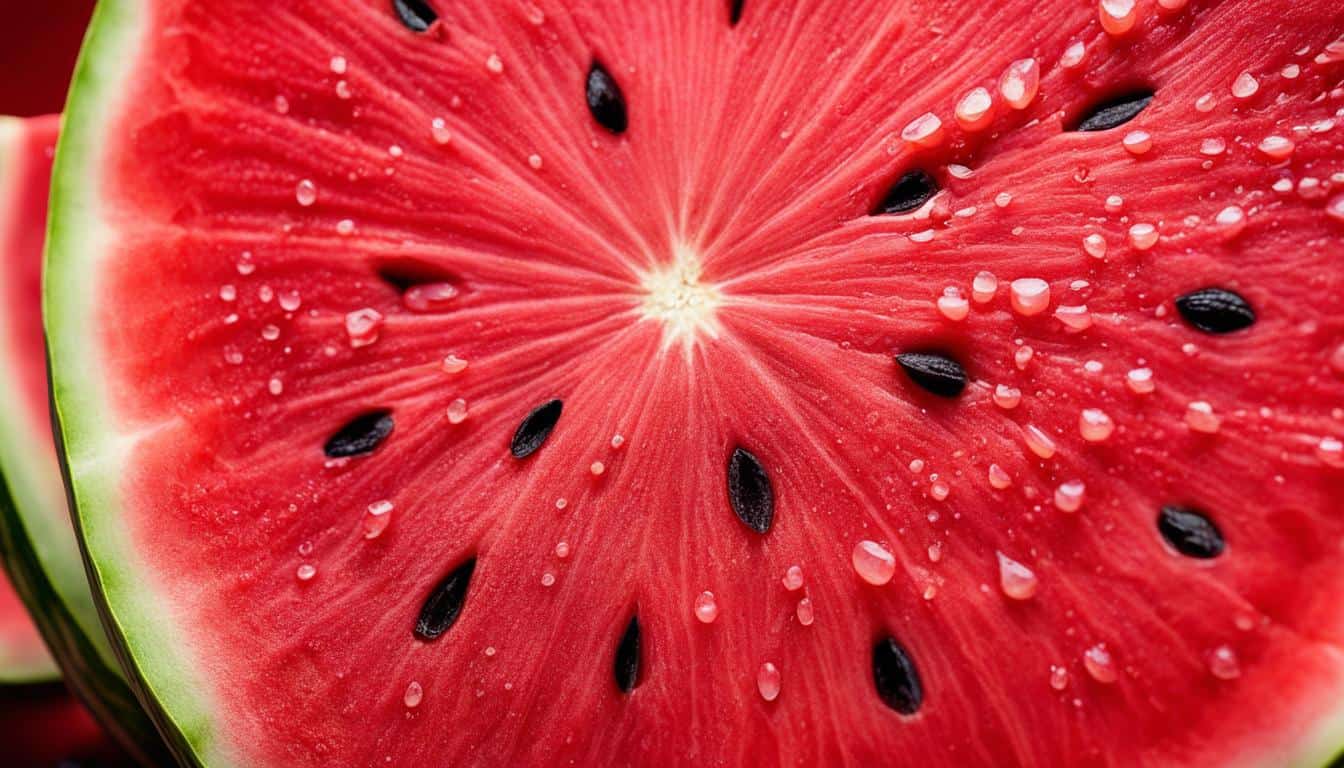



Leave a Reply